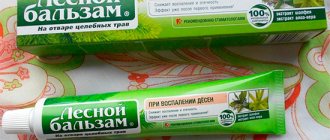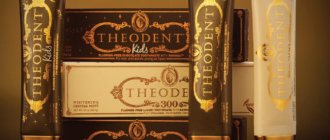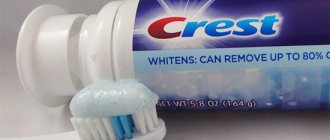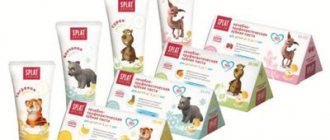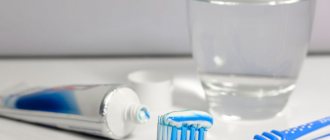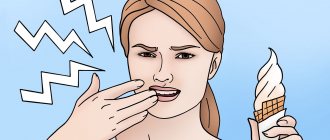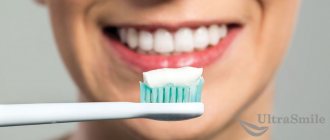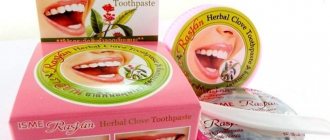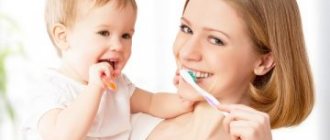Modern toothpaste is a wonderful product, widely used for preventive and therapeutic dental purposes. With its help it is easy to keep your teeth healthy and beautiful. Also, this cleaning product helps to care for the oral cavity, efficiently removes plaque from the surface and remaining food between the teeth, actively fights bad breath and is capable of transporting useful components, thereby preventing the development of caries and gum disease.
But, despite all the above advantages, toothpaste often includes ingredients that are dangerous to human health. And people, unfortunately, pay little attention to this when choosing this or that option. Everyone is more concerned about the price category, taste characteristics or brand awareness. But in vain!
In fact, it is very important to understand what the toothpaste you use regularly consists of. Having such information, you can easily protect yourself and your loved ones from consuming low-quality, harmful products. And if manufacturers don’t care about our health, let’s do it ourselves!
Toothpaste production
How is toothpaste made? First, tap water is purified and disinfected by ozonation. After disinfection, ozone is destroyed using ultraviolet rays, since it should not remain in the toothpaste. Then the toothpaste base is made in special reactors, using purified water, a humectant, a thickener and an abrasive. Boil the base at a temperature of 40 degrees, constantly stirring with a special mixer located in the reactor until a jelly-like mass forms. Next, the resulting product is poured into tubes and sent for laboratory testing. The paste is checked for density, viscosity, color, smell, acid-base balance, etc. The study lasts three days, and if everything is in order, the paste goes into packaging.
Toothpastes that reduce tooth sensitivity
Toothpastes to reduce the sensitivity of tooth enamel contain biologically active components:
- potassium nitrate,
- potassium citrate,
- sodium citrate,
- strontium chloride,
- hydroxyapatite.
SENSODYNE F TOOTH PASTE
Potassium chloride, which is part of Sensodyne F toothpaste, has similar properties.
These compounds, when interacting with the organic substances of the enamel, create a protective barrier that prevents pain reactions to temperature or chemical stimuli (hot, cold, sweet, sour), as well as to mechanical stimuli (when brushing teeth).
Components included in some toothpastes, such as Remodent (3%), calcium glycerophosphate (0.13%), synthetic hydroxyapatite (2 to 17%), help reduce the increased sensitivity of enamel by closing the entrance holes of the dentinal tubules.
This group also includes toothpastes such as Oral-B Sensitive, Lacalut Sensitive.
Classification of teeth cleaning products
- Hygienic pastes designed to clean the surface of teeth from microbial plaque and freshen breath;
- Pastes with anti-inflammatory effect. They contain special medicinal herbs and are used as therapy in the treatment of periodontal diseases.
- Anti-caries drugs. Pastes with a high fluoride content can be used in combination with oral hygiene products to prevent caries.
- Antifungal pastes. Used as prescribed by a doctor to treat certain diseases of the oral cavity.
- Pastes with antimicrobial action. Used in a complex of treatments for the development of diseases of the teeth and gums.
- Pastes with whitening effect. This product contains abrasive particles that effectively remove plaque, but can damage tooth enamel. Therefore, such pastes are not recommended for constant use.
Choosing toothpaste according to problem
When choosing a toothpaste, base it on your current dental situation or problem that is bothering you. Use different pastes in the morning and evening. For example, in the morning - whitening, in the evening - restoring enamel. Change pastes over time - you shouldn’t use the same favorite one all your life.
Raid
Even with healthy teeth and gums, you need to remember about prevention. Daily high-quality cleaning of plaque helps to avoid many problems - unpleasant odor, tartar, caries and gum inflammation.
Strike after strike - discord. Everyone has a mild bacterial plaque, and any good paste should cope with it. But there is a tendency to increased plaque formation or persistent pigmentation due to smoking, coffee, red wine and other coloring products. And this already requires special hygiene products.
It is important to remember here: if plaque is not removed well, it will turn into tartar. You can deal with plaque on your own, but you can deal with tartar only in the dentist’s office.
Choose pastes for daily use with an abrasiveness of no higher than 80 and a fluorine or hydroxyapatite content of at least 950 ppm. Complete your care with an irrigator and mouth rinse.
Unpleasant smell
Bad breath (or halitosis) causes self-doubt for many people. A slight odor from the mouth in the morning is normal. A sharp unpleasant odor that persists throughout the day indicates the presence of some kind of pathology.
The cause of halitosis is the formation of volatile sulfur compounds in the mouth, which are released by bacteria. This happens due to poor hygiene, caries, gum inflammation, and smoking. Halitosis can also be associated with diseases of the gastrointestinal tract, respiratory system and kidneys, diabetes mellitus, taking medications, etc. If serious causes of halitosis are excluded, you can cope with it on your own.
Many manufacturers say that their pastes eliminate bad breath. In reality, they simply disguise it for a while.
Choose antibacterial paste. The composition must contain active components that eliminate volatile sulfur compounds. First of all, it is zinc. Only then will the paste not mask, but actually solve the problem. The composition may also include eucalyptus and thymol oils and charcoal. It is worth supplementing the care with a mouthwash containing the same ingredients.
Sensitive enamel
The problem of enamel sensitivity requires careful and gentle cleaning - any strong impact can cause pain and make it worse. If your teeth react to hot, cold, or sharp things, low-abrasive pastes with an RDA of no higher than 30 are suitable for you. For particularly sensitive enamel, choose pastes with hydroxyapatite, fluorine or calcium in the composition. They will strengthen the enamel, reduce its sensitivity and prevent the problem from reoccurring.
Sensitive gums
Irregular and poor oral hygiene is one of the main causes of inflammation and bleeding gums. An integrated approach is needed here.
Choose pastes containing chlorhexidine, plant extracts (oak bark, sage, chamomile, etc.), allantoin, essential oils (menthol, thymol). To pair with the paste, choose a brush with soft bristles. And don't forget to change it every 3 months. Complete your care with a rinse for sensitive gums.
In the later stages of periodontal disease, pastes with more powerful antiseptics are used: triclosan, chlorine dioxide, zinc. They help remove unpleasant odor, protect gums from inflammation and slow down the accumulation of bacteria. What they all have in common is that they destroy not only pathogenic microorganisms, but also, over time, beneficial microflora. Such pastes can be used in courses of no more than 2-3 weeks, in rare cases - up to 1 month. Otherwise, they can cause oral dysbiosis.
Color change
The reasons for darkening of the enamel can be very different - poor cleaning, smoking, frequent consumption of coffee, tea, red wine. For darkened teeth, a toothpaste with a whitening effect is suitable. If you want to restore natural whiteness or prolong the effect of professional whitening, choose pastes containing papain, bromelain, and carbamide peroxide.
Plaque from coloring products should be removed with abrasive pastes, and the dentin under the enamel should be lightened with the help of peroxides. Thus, carbamide peroxide is the most effective whitening component. And if the paste contains various strengthening and restoring substances, you get not only a whitening effect, but also comprehensive care.
Prevention of caries
Caries is the most common disease in the world. This is a pathological process of destruction of hard tooth tissues. It begins with a white spot and ends with pulpitis and various septic processes with inevitable tooth loss.
The main cause of caries is bacteria that produce acids. They wash fluoride and calcium out of the tooth tissue and weaken it. Frequent consumption of sweets accelerates the development of carious bacteria: carbohydrates are a favorite environment for their reproduction. Teeth with thinned enamel are also at risk: through microcracks, bacteria penetrate into the dentinal tubules and begin to destroy the tooth from the inside.
The most important stage in effectively combating caries is early diagnosis of the problem and, of course, prevention. Remove plaque at least once every 12 hours. Use pastes that contain sodium monofluorophosphate, sodium fluoride, amino fluorides, calcium glycerophosphate, xylitol. They strengthen enamel, fill microcracks and can even cure caries at the white spot stage. Supplement your care by using an irrigator to clean the interdental spaces - the place where a brush fails and where caries most often begins.
Prevention of caries is especially important during pregnancy, when the body actively spends a huge amount of calcium. Therefore, you need to select a remineralizing, anti-caries paste. It should not contain SLS, parabens, synthetic dyes, or a high RDA index.
Ingredients contained in toothpaste
The main components are abrasives, humectants, fluoride and flavorings. One of the main roles is played by abrasive substances, since it is thanks to them that plaque is removed from the surface of the teeth. The most common are calcium carbonate, silicon dioxide and aluminum compounds. These abrasives remove plaque without damaging tooth enamel. Humidifiers in pastes are used to maintain the texture of the product. Almost all pastes contain sorbitol and glycerin. Thanks to these components, the paste has a smooth consistency and is evenly squeezed out of the tube. In addition, the paste contains foaming components that also help cleanse tooth enamel. Fluoride, contained in many toothpastes, reduces the risk of caries and also strengthens tooth enamel. Flavorings and sweeteners are added to toothpaste to give it flavor and a pleasant taste.
Toothpastes containing herbal preparations
Pastes containing herbal preparations improve metabolic processes, tissue regeneration, help reduce bleeding gums, and have excellent deodorizing properties.
In addition to the above mentioned components, their composition also includes adult and children’s dental vitamins, extracts, infusions of medicinal plants, salts, microelements, and enzymes. These pastes are intended both for everyday oral care for preventive and hygienic purposes, and for the prevention of caries, periodontal diseases, non-carious lesions, and diseases of the oral mucosa.
The main types of therapeutic and prophylactic additives included in toothpastes are:
- antiseptics;
- extracts of medicinal plants;
- other active substances.
Local use of antiseptics as part of oral hygiene products is currently becoming widespread. An antimicrobial drug for topical use must meet a number of requirements: high antimicrobial effectiveness, a wide spectrum of action against representatives of opportunistic microflora of the oral cavity, absence of microbial resistance to the drug and pronounced side effects. The most popular antimicrobial ingredients are chlorhexidine and triclosan.
Chlorhexidine is a broad-spectrum antiseptic. Numerous clinical studies have demonstrated the high effectiveness of chlorhexidine against both anaerobic and aerobic bacteria. The mechanism of action of chlorhexidine is not fully understood. The literature describes three main side effects of chlorhexidine:
- superficial staining of teeth and other surfaces in the oral cavity, which is temporary;
- increased formation of tartar:
- short-term change in taste sensations.
For a long time, the introduction of chlorhexidine into toothpastes was problematic due to its poor compatibility with abrasives. However, modern industry has made it possible to create a number of systems that allow the introduction of the described ingredient into abrasive pastes.
Triclosan is a broad-spectrum antiseptic, an ester compound, a phenol derivative. Depending on the concentration, triclosan can have a bacteriostatic and bactericidal effect. The bacteriostatic effect of triclosan is due to the suppression of the absorption of essential amino acids by bacteria. The bactericidal effect is a consequence of disorganization of the cytoplasmic cell membrane. Triclosan has a broad spectrum of antimicrobial activity and is highly compatible with other toothpaste ingredients. It has become widespread because over a decade of its use, not a single clinical case of the development of resistant strains of bacteria or the development of dysbiosis has been described. Toothpaste with triclosan has an anti-inflammatory effect, promoting the accelerated elimination of gingivitis and suppression of pathological processes in periodontitis.
Extracts of medicinal plants are represented in a fairly wide range. These include herbal antiseptics, antioxidants, amino acids, vitamins, macro- and microelements, and compounds with immunocorrective properties. Toothpastes with plant extracts can have a hemostatic, anti-inflammatory, stimulating, wound-healing effect, as well as normalize tissue trophism. Toothpastes may contain extracts of chamomile, sage, nettle, St. John's wort, kelp, mint, calendula, eucalyptus, as well as tea tree oil and some others.
The composition of toothpastes also includes potassium and sodium tetrapyrophosphates, zinc and aluminum compounds, potassium nitrate, strontium chloride and sodium citrate.
Soluble pyrophosphates prevent the mineralization of dental plaque and reduce the amount of supragingival tartar by 32-45%.
Potassium nitrate, strontium chloride and sodium citrate help eliminate tooth sensitivity. The use of such toothpastes by patients with periodontal diseases is especially important, when the pathology results in exposure of the necks of teeth, as well as the formation of wedge-shaped defects.
Zinc and aluminum compounds prevent the precipitation of dyes on the surface of the enamel and slow down the rate of formation of tartar. Toothpastes containing these compounds are usually recommended for smokers and prescribed after professional teeth cleaning.
TOOTHPASTE “Forest”
Lesnaya toothpaste from Nevskaya Cosmetics contains pine chlorophyll-carotene paste, which includes chlorophyll, carotene, balsamic resins, and tocopherol. Chlorophyll preparations have long been known and used in medical practice. They help stop bleeding and activate tissue regeneration processes and have a deodorizing effect.
In 1995, the RA Influenza Institute conducted a study of the antiviral activity of Lesnaya toothpaste. Based on the research results, the following conclusions were drawn:
- the presence of antiviral activity of the chalk-based toothpaste “Lesnaya” against a number of respiratory viruses has been shown;
- using at least 1 g of toothpaste per toothbrush and brushing teeth for at least 2 minutes leads to the inactivation of respiratory viruses, which ensures the sanitization of the oral cavity and the peripharyngeal ring and will prevent the development of the disease.
TOOTHPASTE “NEW PEARL SEVEN HERBS”
Toothpaste “New Pearl Seven Herbs” contains a whole complex of medicinal plant extracts.
- St. John's wort extract has anti-inflammatory, hemostatic, epithelializing and astringent properties.
- Stinging nettle extract has a hemostatic and epithelializing effect, reduces the release of wound exudate, and increases basal metabolism.
- Peppermint extract helps reduce pain sensitivity and has an antiseptic effect.
- Chamomile extract has a disinfectant, anti-inflammatory, analgesic, anti-allergic effect and accelerates tissue regeneration processes.
- Salvia officinalis extract provides an astringent, anti-inflammatory, and disinfectant effect. It is widely used for long-term and poorly healing wounds and oral ulcers.
- Calendula officinalis extract, due to its pronounced anti-inflammatory, epithelializing and regenerating effect, is often used for gingivitis, stomatitis and cracks in the corners of the mouth.
- Echinacea extract has a pronounced immunomodulatory effect.
TOOTHPASTE “NEW PEARL EUCALYPTUS”
Having studied and analyzed the clinical effectiveness of eucalyptus extract, I developed a new toothpaste formula - “New Pearl Eucalyptus”. This extract has a pronounced local anesthetic, vasoconstrictor, anti-inflammatory and regenerating effect, which makes it possible to successfully use it in the treatment of periodontal diseases. In addition, this paste perfectly freshens breath.
TOOTHPASTE “NEW”
“Novinka” toothpaste is one of the best domestic toothpastes both in terms of hygienic (cleansing) and taste properties, and in terms of therapeutic effects on oral tissues. It contains: carotene, vitamins C and K, tocopherol, chlorophyll. The paste has a good cleansing effect, helps reduce inflammatory processes in the periodontium, eliminates bleeding and increases the regenerative activity of the oral mucosa.
TOOTHPASTE “CAMOMILE”
“Chamomile” toothpaste contains hydroalcoholic infusions of St. John’s wort and chamomile, has an anti-inflammatory, antiseptic and astringent effect, and has good cleansing and taste properties.
TOOTHPASTE “SPUTNIK”
Sputnik toothpaste contains spinach extract and aqueous-alcoholic infusion of eucalyptus. Spinach extract contains significant amounts of vitamins C and P and chlorophyll. The composition of eucalyptus infusion includes essential oils and tannins. The paste has a good therapeutic and prophylactic effect on the mucous membrane of the oral cavity and periodontal disease.
CHILDREN'S TOOTHPASTE “BURATINO”
Children's toothpaste "Buratino" contains extracts of chamomile, yarrow and cloves, has a pronounced anti-inflammatory effect, and is recommended for gingivitis.
CHILDREN’S TOOTHPASTE “NUTCRACKER”
Children's toothpaste "Nutcracker" is prepared on the basis of calendula extract, the main components are carotene, lyconin, essential oils, organic acids. The paste has a pronounced anti-inflammatory effect and has phytoncidal properties.
TOOTHPASTE “PARADONTAX”
“Paradontax” is a toothpaste made on the basis of natural substances, prevents the development of bleeding and inflammation of the gums, inhibits the development of bacteria without disturbing the normal microflora of the oral cavity, neutralizes the acidic products of the breakdown of sugars, helps strengthen the gums and teeth, and gives a long-lasting feeling of cleanliness and freshness. The paste contains: peppermint, myrtle, sage, chamomile, ratania, sodium bicarbonate, which allows this paste to be used for the prevention and treatment of inflammatory periodontal diseases.
From all of the above, we can conclude that therapeutic and prophylactic pastes are recommended for widespread use in the complex treatment of periodontal diseases and the oral mucosa.
Composition of children's toothpaste
Before learning more about the composition of children's toothpaste, it is important for parents to remember that their baby needs to brush his teeth from the moment his first teeth erupt. First, you need to clean your teeth using a special fingertip or a children's toothbrush without any toothpaste. In addition, you need to wipe your teeth every day with a small piece of sterile bandage or special napkins for cleaning children’s teeth. You should start brushing your teeth with toothpaste no earlier than two years of age. Before purchasing children's toothpaste, you need to look at the composition of the product. Some children's toothpastes contain harmful ingredients, such as:
- Sodium lauryl sulfate. It is used for better foaming of the product, but at the same time it irritates and dries out the oral mucosa, as a result of which multiple cracks can form.
- Saccharin is a substance used to improve the taste of pasta. An excessive dose of saccharin is dangerous to human health.
- Dyes that can cause allergies to paste.
- Chlorhexidine not only disinfects the oral cavity, but also kills the natural microflora of the mucous membrane.
Toothpaste for adults is not suitable for children, and can also harm children's tooth enamel. In addition, toothpaste for adults quite often provokes a gag reflex in children. That is why baby pastes have a neutral smell and taste.
Compound
If you prepare your own toothpaste, a person knows very well what it consists of. When using a purchased version of a dental cleaner, how can you determine whether it is harmful or not?
It’s very simple: carefully read its composition. Don’t blindly believe beautiful green eco-style labels and manufacturers’ assurances about the natural origin of all paste ingredients. After all, you can write and draw anything you want on a tube, and it is not at all necessary that it will correspond to reality.
Yes, almost all pastes contain natural ingredients. But in what relation to chemical ones: 1% to 100%, 2% or 5%? The answer to this question is always written in small print on the back of the package.
Harmful
Many mass-market toothpastes contain harmful chemicals, the proportion of which in relation to natural ingredients is usually extremely high. And we can say with confidence that when purchasing a paste made using a certain set of components, a person poisons himself.
There are 5 ingredients that should not be in either tooth powder or toothpaste. And not in any proportions.
Table 1. List of the most dangerous components included in mass-produced oral cleansers.
| Name of ingredients | Brief description of properties and principle of operation |
| Sodium laureth sulfate (SLES) and sodium lauryl sulfate (SLS), commonly known as sulfates | These chemical compounds are products of petroleum refining. They have fairly strong oxidizing properties and are also characterized by penetrating ability. Moreover, sulfates are strong allergens, which also does not add any advantages to them. SLS and SLES provide pastes with abrasive, foaming and cleaning properties. But, at the same time, the use of pastes containing sulfates is infinitely harmful, since they do not dissolve in the body, but settle in it. |
| Chlorhexine, metronidazole, triclosan | All these substances are antibiotics. They are usually added to antibacterial toothpastes. While killing harmful bacteria, these components simultaneously destroy the microflora of the oral cavity. That is, they destroy everything: both harmful and useful. |
| Parabens | Propyl, methyl, isobutyl, butyl, isopropyl - all these are parabens, which are preservatives, the main purpose of which is to prevent toothpastes from spoiling. The origin of parabens is unnatural for the human body. After all, these are synthetic products of chemical origin, which, when entering the body, can have a negative effect on the reproductive function of women. Parabens also provoke the development of cancer of the mammary glands, uterus and testes in men, which was proven by scientists back in 2004. |
| Dioform | This substance can be found in toothpastes under the names sim-Dichlorethylene, Acetylene dichloride, or acetylene dichloride, 1,2-Dichloroethene. All of the listed components perfectly lighten teeth, but to the detriment of the enamel. |
| Aluminum lactate | Aluminum lactate is an aluminum salt. More precisely, one of its varieties. It is added to the paste as an anti-inflammatory substance that stops bleeding gums. Also, by affecting the nerve endings of the teeth, aluminum lactate reduces their sensitivity. In this case, the signal transmission from external stimuli does not enter the nerve, and the person no longer feels discomfort when eating cold, hot, sweet or sour. But this does not mean that the teeth have lost sensitivity, this is only an effect created due to the action of a chemical compound. That is, fighting hypertension by brushing teeth containing aluminum lactate is equivalent to treating a painful tooth with a “hole” by constantly taking painkillers. |
There is also a more controversial list of ingredients contained in toothpaste, which is often called all-natural by manufacturers. The nature of their origin is chemical, but they cannot be called particularly dangerous.
Some consider these components neutral in relation to the human body, while others consider them harmful. In any case, they are definitely not capable of having the same detrimental effect on health as, for example, sulfates, antibiotics and parabens.
Table 2. Controversial components of toothpastes regarding possible harm to the body.
| Ingredient name | Short description |
| Sodium carboxymethylcellulose | It is a stabilizer used as a food additive. It is obtained from soda and cellulose. If you rely on conclusions drawn after individual studies, then this component can cause skin irritation, allergies, and stomach upset. However, this is just an assumption that has not been proven. |
| Titanium dioxide | This is a clarifier that gives the paste a snow-white color. In general, the substance is considered absolutely harmless, since it is not retained in the body and is excreted from it in full. But not everyone agrees with this statement. The thing is that experiments performed on mice during muscle research showed the opposite. But at the same time, the mice were given a very large dose of titanium dioxide, so you should not blindly believe the conclusions of these experiments. |
| Saccharin | A well-known sweetener of synthetic origin. Approved in the EU, Russia and the USA. Some people consider saccharin to be a carcinogen. However, this is a subjective opinion, not supported by specific facts. |
| Sodium lauryl sarcosinate | This is the same surfactant, but much more gentle than sodium lauryl sulfate. It is easily removed from the human body without accumulating in it. |
| Cocamidopropyl | Again, it is a surfactant. With its help, the paste becomes thicker and acquires the ability to foam. Made from coconut oil fatty acids. Does not cause significant harm to the body. In extreme cases, it can cause allergies or inflammation of the mucous membrane. |
Safe
Even truly natural toothpastes contain chemical components, albeit in a minimal amount, usually not exceeding 1-5%. They mainly improve the external and taste qualities of the product.
Natural toothpaste also contains components that, at first glance, have scary names that resemble synthetic compounds. But in fact, these ingredients are made from natural materials and are completely harmless.
The thing is that during the manufacture of hygiene products, the natural ingredients used are subjected to extreme processing: evaporation, hydrolysis, heating, pressure. As a result, there is nothing useful left in them, but nothing harmful either.
Table 3. Neutral components in natural toothpastes.
| Substance name | Short description | Functions performed |
| Xylitol | Found in some fruits and vegetables, birch bark, corn cobs | Sweetener |
| Silicon oxide | It is an alternative to calcium carbonate due to less abrasiveness | Plaque removal |
| Sorbitol | It is made from berries and leaves of rowan, plum, cherry, apple, pear, seaweed. | Sweetener |
| Vegetable glycerin | It is obtained by hydrolysis of vegetable oils | Responsible for the “binding” properties of the paste |
| Zinc citrate | Contained in the human body | Helps slow down the hardening of plaque |
| Sodium benzonate | Used as a food additive. In nature, in small doses, it is found in cranberries, apples, raisins, cloves, cinnamon and others. | Preservative |
| Xanthan gum | Is a food additive. Produced by fermentation from sugar syrup. Approved in the EU, Russia and the USA | Thickener |
| Sodium citrate | This is a salt of citric acid. Made by neutralizing acid with sodium | Responsible for regulating pH levels |
| Sodium silicate | This compound is widely distributed in nature. Is a food additive. | Makes the paste structure homogeneous |
| Potassium sorbate | It is obtained by neutralizing sorbic acid contained in rowan juice. | Preservative |
| Maltodextrin | It is a product of starch hydrolysis (molasses) | Improves the binding properties of the paste |
Natural toothpastes should ideally contain only natural ingredients, but finding such a product is not an easy task. In any case, if the dental cleaner consists of: natural clay, calcium carbonate, soda, silicon, essential oils, sea salt, coconut oil, herbal extract and powder, and their total content is over 95%, then such a paste has an ideal composition, and it is worth buying with confidence. All of these components are not only harmless, but also useful.
Toothpaste made from natural ingredients
Natural toothpaste does not contain any dyes, flavors or preservatives that can destroy tooth enamel. Pastes consisting of natural herbs and plants have a number of healing properties:
- freshen breath;
- have an anti-inflammatory effect;
- remove dental plaque;
- prevent the growth of bacteria in the oral cavity.
Due to their natural composition, such pastes do not foam well, so they require more thorough cleaning of the oral cavity. Such pastes usually consist of herbal and plant extracts and are most often green in color. The product typically contains bromelain, a component found in pineapples. Bromelain reduces gum swelling, kills bacteria and protects the oral cavity from harmful microorganisms. Licorice extract is also added to natural toothpastes, which has a strong anti-inflammatory effect. Licorice reduces bleeding gums and reduces the level of sensitivity of tooth enamel. In addition, natural toothpastes may contain extracts of various essential oils.
The best toothpastes for caries prevention
There are a huge number of manufacturers that produce pastes to protect against caries. We list the products recommended by dentists and chosen by customers:
- ROCS "Active calcium".
- Weleda with calendula.
- SPLAT Professional "Whitening Plus".
- Biorepair Plus Total Protection.
- CURAPROX Perio Plus Support.
- Apadent Perio.
- PERIOE Pumping Original.
- Marvis Orange Blossom Bloom.
- Dentissimo Complete care.
- Mirafluor C Toothpaste with Amine Fluoride.
Let us describe the main features of the pastes presented in the rating.
ROCS "Active calcium"
Contains a high concentration of calcium, which is built into the structure of tooth enamel due to a special activation system. After several weeks of using the paste, teeth become lighter. The main thing is that their resistance to caries increases. In addition to calcium, the composition includes phosphorus, silicon and magnesium, which ensure remineralization of enamel.
The paste contains xylitol, a natural component that prevents the proliferation of cariogenic microbes and maintains the balance of oral microflora. The abrasiveness of the composition is low, so this product can be used by people with increased sensitivity of the gums.
pros
- suitable for daily use;
- protects against bacteria and caries;
- saturates the enamel with minerals;
- very refreshing.
Minuses
slow whitening effect.
Weleda with calendula
A medicated toothpaste based on calcium carbonate, which effectively removes plaque from teeth and provides protection against caries. Contains calendula extract. It has an anti-inflammatory and calming effect. The paste does not contain mint; it contains fennel essential oil as a refreshing component. It can be used by people with individual intolerance to mint components. In addition, the paste contains no synthetic dyes, preservatives, flavors or bleaches.
pros
- anti-inflammatory effect;
- suitable for adults and children;
- not harmful if swallowed.
Minuses
- no fluoride in the composition.
SPLAT Professional "Whitening Plus"
SPLAT pastes are one of the most famous therapeutic and prophylactic dental care products. "Whitening Plus" is based on an innovative safe cleansing system. The composition includes rounded polishing particles, which, in combination with natural ingredients, lighten the enamel without harming it or the gums. The Polydon substance breaks down plaque in hard-to-reach places, making the surface of the teeth smooth.
The paste contains antibacterial components that prevent cariogenic microorganisms from multiplying. SPLAT Professional is ideal for tea and coffee lovers, as well as smokers. The fluoride content in the paste is 1000 ppm, which corresponds to a moderate therapeutic and prophylactic effect.
pros
- suitable for tooth sensitivity;
- cleans and polishes enamel;
- prevents plaque from settling.
Minuses
- Buyers note that this paste has no shortcomings.
Biorepair Plus Total Protection
A paste that reduces the hypersensitivity of enamel and gums, restores damaged dentin, creates a protective layer on the tooth surface, mineralizes the enamel and protects it from acids and microbes. Biorepair Plus Total Protection contains unique microRepair particles. Their composition is identical to hydroxyapatite, which is the basis of natural enamel and dentin. These particles have a needle-like structure, and therefore easily integrate into the surface of the tooth, filling cracks and restoring mineral balance. This ensures the prevention of caries.
pros
- the feeling of cleanliness lasts until the morning;
- polishes and cleans teeth;
- restores damaged areas of enamel;
- has an antibacterial effect.
Minuses
- high price.
This paste is used before and after dental surgery, for the treatment of periodontal diseases, to prevent gum damage, for tissue restoration and after the installation of orthodontic structures. CURAPROX Perio Plus Support also helps prevent caries. It is recommended to use it for no more than 6 months and as prescribed by a doctor.
The paste maintains the balance of oral microflora and has an antibacterial effect. After brushing your teeth, the process of plaque formation on the teeth slows down due to the formation of a protective film on the enamel. This ensures an anti-caries effect.
pros
- suitable for treatment and prevention;
- can be used after installing braces;
- has an antibacterial effect;
- does not change taste sensations;
- does not contain synthetic dyes.
Minuses
- high price;
- can be used for no more than six months.
This toothpaste is used not only to prevent caries, but also to treat it at the initial stage. The composition includes ocean salt, which has a calming effect. Apadent Perio is suitable for people with sore and bleeding gums. The paste contains antibacterial components that prevent the spread of cariogenic microbes. To strengthen the enamel throughout its depth, a bioactive mineral, which makes up human tooth enamel, is introduced into the composition. The paste has a pleasant minty-salty taste without the aftertaste of medicine.
pros
- suitable for dental hypersensitivity;
- pleasant to the taste;
- removes plaque and brightens enamel.
Minuses
- high cost.
PERIOE Pumping Original
One of the most effective toothpastes for caries prevention. It contains sodium fluoride in a concentration of 1400 ppm, which allows you to remove plaque, including deep plaque, destroy bacterial decay products and cleanse the oral cavity of harmful microbes even in hard-to-reach places. Fluoride helps remineralize enamel, making it more resistant to acids.
PERIOE Pumping Original comes in a convenient bottle with a dispenser: no need to squeeze the toothpaste out of the tube, just press the pump. So it is consumed more slowly. In addition, it foams well, so you need to apply it to the brush in a minimal amount. The bubbles formed during cleaning envelop the enamel, penetrating into the interdental spaces, which allows you to better clean your teeth from food and germs.
pros
- high fluoride content;
- convenient packaging;
- economical consumption.
Minuses
- high price.
Marvis Orange Blossom Bloom
Anti-caries paste based on calcium and fluoride. Has a soft creamy structure. Whitens teeth well and protects them from plaque. The paste is designed to maintain oral health and is used to prevent diseases of teeth and gums. The composition includes a citrus flavor of natural origin, providing a fresh effect. Marvis is produced in original retro packaging.
pros
- interesting tube design;
- minerals in the composition;
- pleasant citrus flavor.
Minuses
- Possible allergy to the citrus component.
Dentissimo Complete care
A paste made from plant extracts that have a calming effect. After using Dentissimo Complete, the sensitivity of the gums decreases and they stop bleeding. In addition, the paste restores the natural color of teeth. The composition includes calcium and hydroxyapatite, which replicates the structure of tooth enamel and strengthens it. The paste also contains extracts of geranium and eucalyptus. The first has an antiseptic effect, the second has a refreshing effect.
pros
- complex action;
- suitable for permanent use;
- contains calcium.
Minuses
- If you believe customer reviews, this product has no shortcomings.
Mirafluor C Toothpaste with Amine Fluoride
Toothpaste recommended for use to strengthen enamel and prevent caries. The main component of the composition is amino fluoride, which reacts with saliva and more effectively cleans teeth of plaque. This substance remains in the oral cavity for 3-5 minutes after brushing, providing fluoridation of the enamel.
The paste has a low degree of abrasiveness. It can be used by people with hypersensitive teeth and gums. There is no risk of damage if properly cleaned.
pros
- amino fluorides and calcium in the composition;
- suitable for tissue sensitivity;
- low degree of abrasiveness.
Minuses
- contains flavorings.
Before you start using medicated toothpaste, visit your dentist. He will select a product with a suitable composition. Do not try to cure caries and other oral diseases with it. Therapeutic paste is a supplement, not an alternative, to dental procedures.
You can order toothpaste on our website. In the catalog you will find other products presented in the rating.
Toothpastes containing various dietary supplements
Toothpastes containing biologically active additives have anti-inflammatory and regenerative effects, which allows them to be used in the treatment of gingivitis, periodontitis and other diseases of the oral mucosa.
TOOTHPASTE “PRIMA”
Prima toothpaste contains vitamin B5 and has anti-inflammatory and regenerative effects.
TOOTHPASTE “BOROGLYCERINE”
Boroglycerin toothpaste contains 10% boroglycerin, which provides it with active antiseptic, bacteriostatic, bactericidal, fungistatic and fungicidal effects. The paste is advisable to use for acute and chronic candidiasis, stomatitis, glossitis and cheilitis, as well as for inflammatory periodontal diseases (gingivitis, periodontitis and idiopathic periodontal diseases).
TOOTHPASTE “BERRY”
“Yagodka” toothpaste contains 7% boroglycerin, which also provides an antiseptic effect against Staphylococcus aureus. It is recommended to use it 3-4 times a day in the treatment of candidiasis.
TOOTHPASTE “NEW PEARL EXTRA”
“New Pearl Extra” is the first toothpaste that contains kelp seaweed extract, which enhances the body’s immune response. In a study conducted under the guidance of Professor Yu.A. Fedorov, it was found that this paste significantly reduces the severity of periodontitis due to the natural extracts included in the formulation.
How to choose toothpaste - the right composition and tricks of manufacturers
The history of toothpaste began in 1837, when the American brand Colgate released the first toothpaste in a glass jar. In Russia, toothpastes in tubes appeared only in the middle of the 20th century.
Manufacturers are expanding the functionality of toothpaste: now it is designed not only to clean teeth from food debris and plaque, but also to treat oral diseases. Your dentist can help you choose the right toothpaste for your needs.
Toothpaste for children
Oral hygiene must begin from an early age, as soon as the child’s first incisors appear.
When choosing children's toothpaste, pay attention not only to attractive packaging and taste. Adult toothpastes are not suitable for children; you can switch to them when the child turns 14 years old.
All toothpastes for children are classified according to three age periods:
- 0-4 years;
- 4-8 years;
- 8-14 years old.
Correct composition
The main three criteria for any baby toothpaste are a safe and hypoallergenic composition, a preventive effect and a pleasant taste. The combined paste base cares for the thin enamel of a child’s teeth, has a soft aroma and taste, so that brushing your teeth turns into a daily ritual.
The components of toothpaste should have a beneficial effect on children's teeth. Useful substances that are necessary in toothpaste for children:
- vitamin complexes;
- actoperroxidase, lactoferrin;
- calcium glycerophosphate/calcium citrate;
- dicalcium phosphate dihydrate (DDCP);
- casein;
- magnesium chloride;
- lysozyme;
- xylitol;
- sodium monofluorophosphate;
- aminofluoride;
- zinc citrate
- glucose oxide;
- plant extracts - linden, sage, chamomile, aloe.
Due to the listed components, the protective functions of saliva are improved and tooth enamel is strengthened.
Among the components of the toothpaste there are neutral ingredients that are responsible for the appearance and consistency. They are safe for the child. These are glycerin, titanium dioxide, water, sorbitol and xanthan gum.
Harmful components
When buying toothpaste for your child, remember about substances that are dangerous to his health.
Fluorine
Fluoride improves the mineralization of teeth. But if swallowed, it becomes toxic and can provoke the development of neurological disorders and thyroid pathologies. Its excess in the body will lead to fluorosis - pigmentation of teeth and greater susceptibility to caries. Always consider the ppm index, which indicates the concentration of fluoride in toothpaste.
Permissible dosage of the substance in a tube of paste:
- for children under 3 years old - no more than 200 ppm;
- from 4 to 8 years - no more than 500 ppm;
- from 8 and older - no more than 1400 ppm.
If you have any doubts about giving your child fluoridated toothpaste, consult a specialist.
Antibacterial substances
These are triclosan, chlorhexidine, and metronadazole. When used frequently, they destroy not only harmful bacteria, but also beneficial ones. As a result, the microflora of the oral cavity is disrupted. The use of toothpaste with any of the above substances is allowed for pathologies:
- gingivitis;
- stomatitis;
- periodontitis.
In other cases, it is better to choose a paste without disinfecting properties.
Abrasives
Commonly found components are calcium carbonate and sodium bicarbonate. These substances are too aggressive for children’s teeth and can harm them. It is better to purchase a paste with silicon dioxide (or titanium dioxide). The degree of abrasiveness is indicated by the RDA index.
Foaming agents
This group of components provides a uniform consistency of toothpaste to make teeth brushing easier. The most common foam former is sodium lauryl sulfate - E 487, SLS. The substance dries the oral mucosa and can provoke an allergic reaction.
Synthetic thickeners
Acrylic acid and cellulose are the main binding elements of synthetic origin, which are very toxic. Therefore, choose a paste with a natural thickener - resin from seaweed, plants or trees.
Whitening components
You saw carbamide peroxide derivatives in toothpaste for children - discard it. The whitening effect will not be noticeable, but the tooth enamel will become thinner. As a result, the risk of caries and dental problems will increase.
Preservatives
For long-term transportation and storage, preservatives are added to toothpastes to prevent the growth of bacteria. The most commonly used is sodium benzoate, which is dangerous in large doses. There are also other preservatives - propylene glycol (PEG) and propylparaben.
Artificial colors and saccharin
The harmful effects of sugar-containing substances are known - the formation and development of caries increases. Chemical dyes will ruin the tone of your child's teeth.
Flavor enhancers
You should not give your child toothpaste containing eucalyptus or mint extract, as they have a strong taste. Buy pastes with menthol, anise and vanillin.
Leading brands
Here are the top 5 children's toothpastes that are approved by many parents and dentists.
ROCS Pro Kids
Toothpaste for children 3-7 years old, with wild berry flavor. Contains xylitol, calcium and honeysuckle extract. According to the manufacturer, 97% of the paste’s components are of organic origin.
Rocks toothpaste for children helps normalize oral microflora, strengthen tooth enamel, prevent gum inflammation and the formation of caries, slow down the process of plaque formation and freshen breath.
Lacalut Teens 8+
Tooth gel for teenagers contains sodium fluoride, amino fluoride, methylparaben, citrus-mint flavor. Helps fight tooth decay, relieve gum inflammation, eliminate plaque and slow down the growth of bacteria.
Splat Baby
The Russian pharmaceutical company Splat offers toothpaste for children from 0 to 3 years old. Available in 2 different flavors: vanilla and apple-banana. Hypoallergenic and not dangerous if swallowed, as it consists of 99.3% natural ingredients.
Effectively protects against caries and facilitates the eruption of the first teeth. Prickly pear extract, chamomile, calendula and aloe vera gel reduce unpleasant gum sensitivity, destroy bacteria and relieve inflammation.
Eared Nian. First tooth
Another domestic manufacturer presents toothpaste for little ones. Aloe vera extract included in the composition reduces pain when teething. The paste is not dangerous if swallowed, thoroughly cleans children's teeth and reliably strengthens the enamel. Does not contain fluoride.
President TEENS 12+
For teenagers, the President company offers a mint-flavored paste that does not contain harmful substances - allergens, parebens, PEGs and SLS. Universal toothpaste stimulates the remineralization process, protecting the child's gums and teeth.
Toothpaste for adults
Mature teeth are adapted to the aggressive ingredients in toothpastes, but should not be exposed to toxins. Toothpastes for adults are designed to solve various oral problems.
The concentration and composition are determined by the purpose of a particular type of paste.
Kinds
Adult toothpastes are divided into several classes:
- treatment and prophylactic;
- therapeutic or complex;
- hygienic.
Treatment and prevention
This group of pastes eliminates factors that over time can cause the development of oral diseases. Examples are toothpastes with anti-inflammatory, antisensitivity effects that prevent the formation of tartar.
Therapeutic or complex
This group of toothpastes includes products that are aimed at eliminating pathology. Such pastes perform several tasks at once, which is why they are called complex pastes. For example, whitening and anti-caries, antimicrobial and anti-inflammatory, against bleeding gums.
Hygienic
The third group of toothpastes for adults is designed to remove plaque, food debris, clean teeth and freshen breath. Pastes of this type are suitable for people who do not suffer from oral diseases.
Toothpastes for adults can also be grouped by method of use:
- for daily care;
- for one-time or course use - usually 2 weeks. An example is whitening toothpastes.
Correct composition
The number of chemical components of toothpaste for adults is represented by a wide list.
- vitamin complexes;
- lactoperroxidase/lactoferrin;
- calcium citrart/calcium glycerophosphate/calcium hydroxyapatite;
- dicalcium phosphate dihydrate/sodium monofluorophosphate/aminofluoride;
- xylitol;
- casein;
- lysozyme;
- magnesium chloride;
- zinc citrate
- glucose oxide;
- plant extracts - linden, sage, chamomile, aloe, nettle, kelp.
Harmful additives
The following are added to toothpastes as additional substances:
- Antiseptics - chlorhexidine, metronidazole and triclosan. Only the latter has a gentle effect.
- Fluorine. Suitable for those who do not have fluorosis and do not have an excess of the element in the body as a result of drinking running water with a high fluoride content. For the rest, it is better to choose toothpastes without fluoride.
- Potassium strontium nitrate or chloride. Substances increase the “exfoliating” effect. People with sensitive teeth and gums should avoid such toothpastes and choose those that use silicon dioxide.
Leading brands
We present a rating of popular and effective toothpastes for adults.
PRESIDENT Unique
The Italian brand offers development with a unique non-fluorinated composition. Xylitol, papain, glycerophosphate and calcium lactate help gently remove plaque, prevent tartar formation and restore natural whiteness.
Elmex Sensitive Professional
Mineralizes hard tissues, reduces the sensitivity of gums and teeth, and has an anti-caries effect. The composition contains amine fluoride, which relieves inflammation. Due to its low abrasiveness (RDA 30), the paste gently cleanses teeth, preventing the formation and development of caries.
Parodontax
The German paste has been receiving consumer approval for several years now due to its tangible healing effect and organic ingredients. Echinacea, ratania, sage and chamomile, included in the paste, reduce bleeding gums, have an antibacterial effect, and relieve inflammation. Available in two formulas: with and without fluoride.
ROCS Pro – Delicate whitening
The paste is suitable for those who want a snow-white smile, but without harmful effects on the teeth. The formula without lauryl sulfate, parabens, fluoride and dyes will help to gently and without damage lighten tooth enamel, remove inflammation and freshen breath.
Lacalut Basic
Available in three flavors: classic mint, citrus and blackcurrant with ginger. Promotes remineralization of tooth enamel, strengthens gums and protects against caries.
How to choose toothpaste by strips
You can find out the safety level of a certified paste by looking at the horizontal stripe on the seam of the tube. A black stripe indicates the presence of only chemical elements with a high degree of toxicity in the paste.
- Blue stripe - 20% of this paste consists of natural ingredients, and the rest is preservatives.
- Red stripe - 50% organic matter.
- Green stripe - maximum safety of the components in the toothpaste - over 90%.
Marketing Tricks
In order to “promote” and sell the product to a larger number of buyers, toothpaste manufacturers resort to manipulation when drawing up slogans and product descriptions. Let's figure out what formulations you shouldn't pay attention to when choosing toothpaste for yourself or your child.
“The pleasant sweet taste and smell of the paste will make brushing teeth a child’s favorite pastime.”
Toothpaste for children must be healthy, and only then pleasant to the taste. Let it be tasteless or at least not cloying, so as not to develop the habit of eating pasta in your child. Artificial sweeteners increase the risk of tooth decay significantly.
“The toothpaste does not contain preservatives. Contains only natural ingredients"
A toothpaste that is stored on a store shelf for several months, or even years, cannot have only an organic composition. The path from the manufacturer's factory to the buyer is long, therefore, preservatives are added to any toothpaste.
“Only expensive luxury toothpaste gives noticeable and long-lasting results”
Oral hygiene products vary in price solely based on the “respectability” of the brand. World-famous import brands inflate the cost of toothpaste, despite the fact that a similar composition can be found in a budget option. The main thing you should pay attention to when buying toothpaste is the component composition and purpose.
"Suitable for the whole family"
Microflora and oral cavity problems are individual for everyone, so do not choose a paste with such a collective appeal. Each family member should ideally have a personal toothpaste that suits their characteristics and taste preferences.
